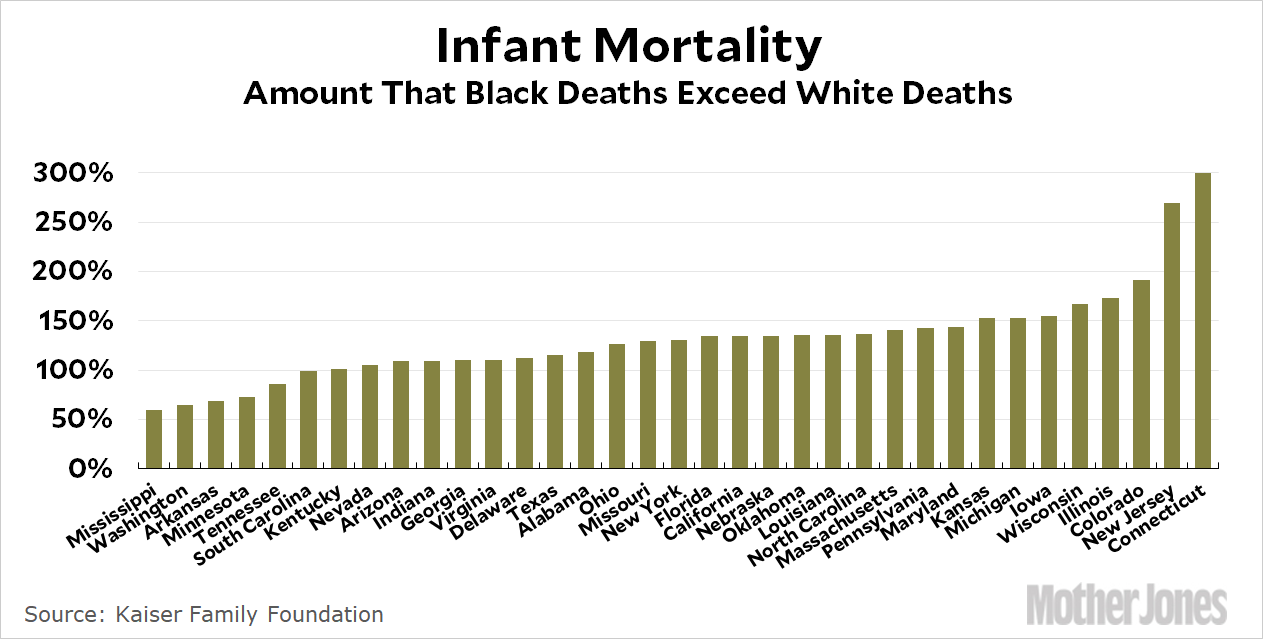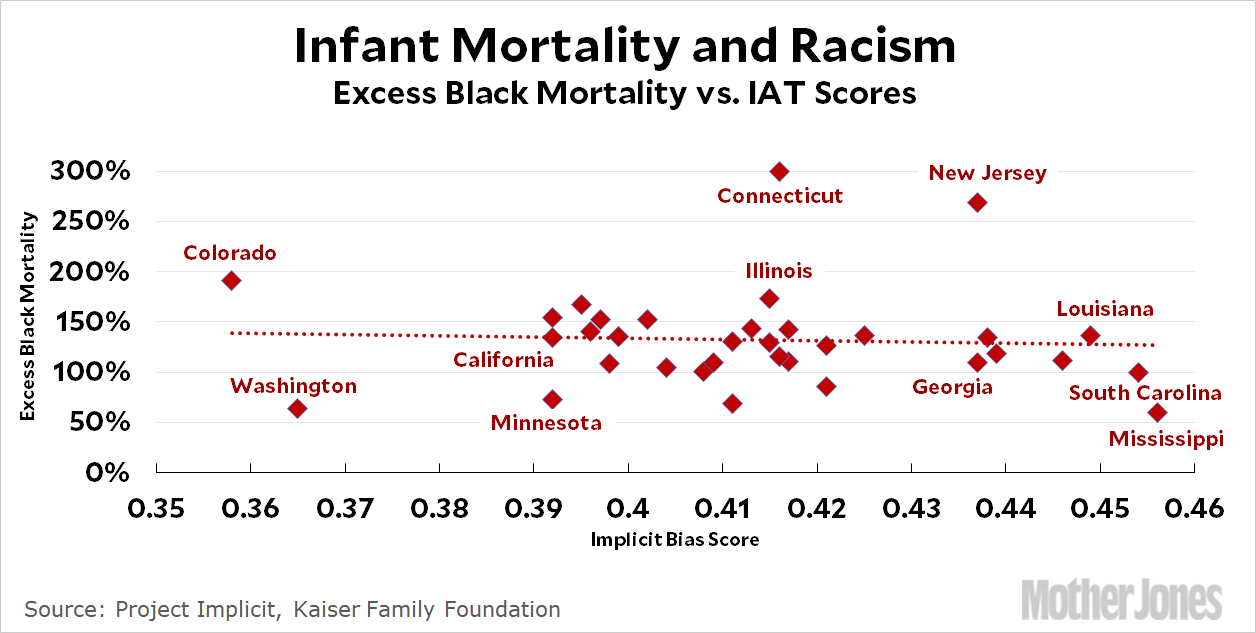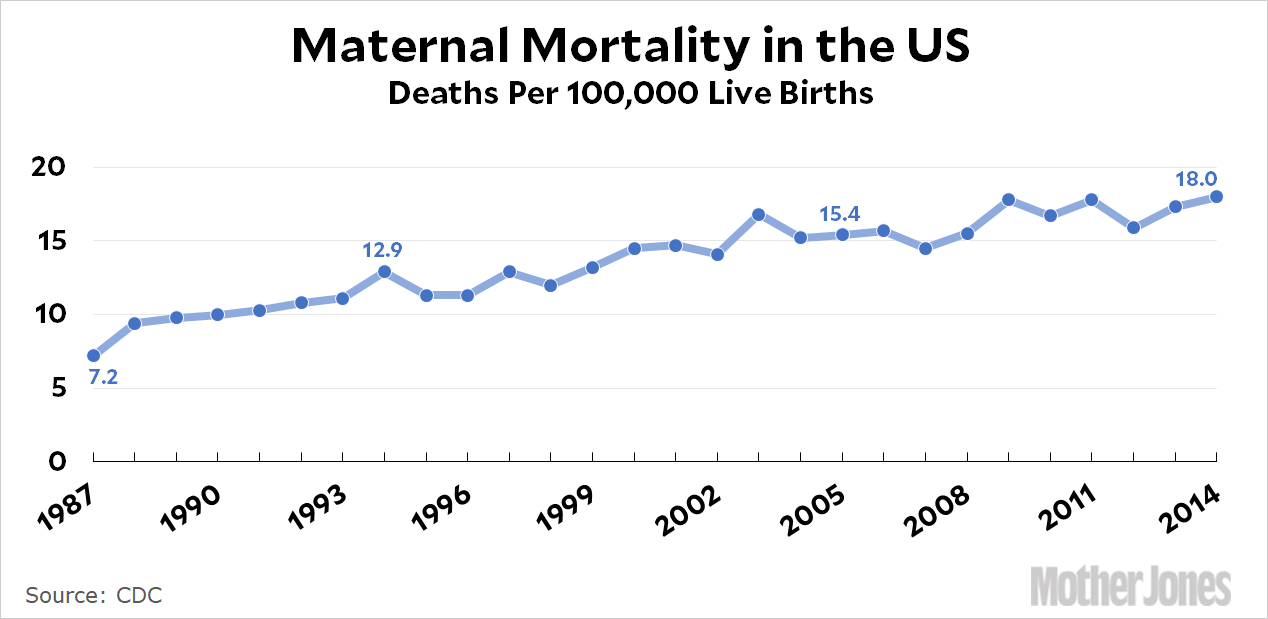Over at New York, Sarah Jones criticizes Elizabeth Warren’s plan to reduce maternal mortality among black mothers, which relies on penalizing hospitals with high mortality rates. I think Jones is right about that: taking money away from hospitals that are already probably struggling for resources doesn’t make sense. What makes better sense is to look to California for guidance: in the past decade it’s cut maternal mortality in half thanks to the efforts of the California Maternal Quality Care Collaborative. What they do is surprisingly simple: figure out the major causes of maternal death, focus on how to prevent them, and then get hospitals obsessed about having those treatments ready for every delivery.
But something else Jones said also got my attention:
Warren is right to identify implicit bias as a major contributing factor to rates of death for black mothers. As ProPublica reported in 2017, black women in wealthy neighborhoods — where hospitals are likely to be well-funded, high-quality institutions – are still much more likely to die from pregnancy complications. In 2014, black Americans comprised a mere 4 percent of the nation’s physician workforce, and medical school doesn’t root out racism from the psyches of their white colleagues.
I wondered if this was true. The problem is that it’s nearly impossible to figure out. We already know that the black maternal death rate nationally is far higher than the white rate, but if we want to know why it’s higher we have to search for differences among subgroups that might provide an explanation. Basically, we need to break out the data in some way that allows us to compare, say, each state’s maternal death rate to its racial attitudes. Unfortunately, we can’t do that. There are only about 700 maternal deaths in the US each year, and if you slice and dice this by state and race you end up with lots of tiny sample sizes even if you use multiple years of data.¹
But it occurred to me that I could look at infant mortality instead, which happens in far higher numbers. A quick check confirmed that at a state level it correlates pretty well with maternal mortality—not perfectly, but with such small sample sizes that’s hardly to be expected. First, then, here is the infant mortality rate by state:

At first glance this doesn’t seem to support the idea that implicit racism among doctors is at fault. At the left are the states with the lowest rate of excess black deaths relative to white deaths. It includes states like Mississippi, Arkansas, and South Carolina—not places that we typically associate with liberal racial attititudes.
So let’s take a closer look. What happens if we compare the numbers above with state averages on the Implicit Association Test, which is supposed to measure racial bias even if it’s unconscious? Here you go:

There’s nothing there. The trendline is basically flat and has a lousy correlation coefficient. The states on the far right are both poor and racist, but black infant mortality relative to white is no worse than states on the left, which are both richer and less racist.
Now, there are loads of problems with all this. First there’s my assumption that racial differences in infant mortality are a good proxy for racial differences in maternal mortality. There’s the assumption that the IAT is a good test of bias, which is far from certain. There’s the lack of any controls for things like education, access to insurance, and so forth.
But even acknowledging all that, this rough look doesn’t seem to support the proposition that implicit bias among doctors is responsible for black mothers having a higher maternal mortality rate than white mothers. Plus there’s the experience of California: they cut their maternal mortality rate in half, and presumably this wasn’t because the state’s doctors suddenly all had racial epiphanies over the past decade. Instead, they focused on what kind of medical care was needed to prevent maternal deaths, and then pressed hospitals to get serious about it. There’s also this:

This is insane: over the past three decades maternal mortality has doubled in the US while it’s gone down everywhere else. More importantly, it’s been rising across the board. This suggests that maternal mortality is more a consequence of a broad medical breakdown than it is of some specific racial problem among doctors.²
All that said, I wouldn’t be at all surprised if implicit bias plays a role in the higher level of black maternal mortality. In fact, I’d be surprised if it didn’t. For one thing, we know it does in at least a few other areas of medicine. Still, if we’re going implicate racism here, it should be based on evidence.
POSTSCRIPT: Here’s the data I used:
- Overall infant mortality: CDC
- Black/white infant mortality: Kaiser Family Foundation
- National maternal mortality: CDC
- State-by-state maternal mortality: USA Today study
- Implicit Bias by state: Project Implicit
¹Just as an example, Nebraska has 0.6 percent of the population of the US, which means you’d expect about four maternal deaths per year. African Americans make up 5 percent of Nebraska’s population. This means that even over ten years you’d expect maybe 36 white maternal deaths and 4 black maternal deaths. There are lots of states like this, and those numbers are way too small to produce any kind of meaningful comparisons.
²It also suggests that the rise might be an artifact of reporting rather than something real. There’s some evidence of this, but not enough to draw any firm conclusions.














